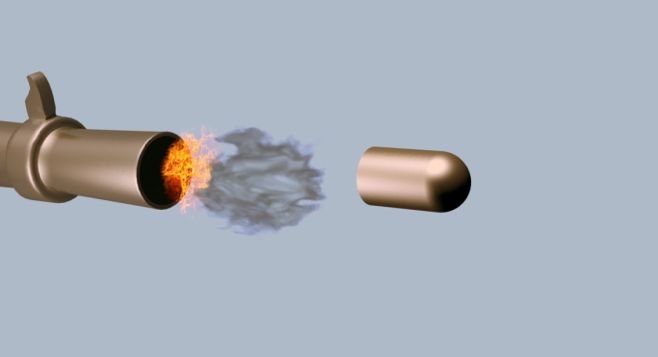 Facebook
Facebook
 X
X
 Instagram
Instagram
 TikTok
TikTok
 Youtube
Youtube

Heymatt:
Do bullets thrown into a campfire go off with the same velocity as when they are fired from a gun?
— Perplexed
The short answer is “no.” I actually saw this one on Mythbusters. They dumped a hundred rounds of various calibers in a fire and let them all go off. Nothing that looked like a lethal wound resulted and there are a few reasons why.
Firstly, bullets achieve their deadly velocity because the barrel of the gun channels the energy that’s released when the powder burns inside the shell. The hot, trapped gas in the chamber has nowhere to go and it pushes the bullet forward until it can all escape out the muzzle of the firearm. As bullets are made of lead and very heavy for their size, they require a certain amount of time to accelerate. When the round isn’t encased in the gun, all that hot gas just whooshes out into the surrounding air and the majority of the energy is wasted.
Secondly, when you throw a bullet in a fire (or hit it with a hammer like a YouTube moron) it usually fires backward. The lightweight, brass casing tends to fly away from the heavy, lead bullet because it has a much lower moment of inertia. When people do foolish things with ammunition, they usually end up getting hit with the casing instead of the bullet. A hot piece of flying brass hurts like heck, but it lacks the mass to be really dangerous.


Heymatt:
Do bullets thrown into a campfire go off with the same velocity as when they are fired from a gun?
— Perplexed
The short answer is “no.” I actually saw this one on Mythbusters. They dumped a hundred rounds of various calibers in a fire and let them all go off. Nothing that looked like a lethal wound resulted and there are a few reasons why.
Firstly, bullets achieve their deadly velocity because the barrel of the gun channels the energy that’s released when the powder burns inside the shell. The hot, trapped gas in the chamber has nowhere to go and it pushes the bullet forward until it can all escape out the muzzle of the firearm. As bullets are made of lead and very heavy for their size, they require a certain amount of time to accelerate. When the round isn’t encased in the gun, all that hot gas just whooshes out into the surrounding air and the majority of the energy is wasted.
Secondly, when you throw a bullet in a fire (or hit it with a hammer like a YouTube moron) it usually fires backward. The lightweight, brass casing tends to fly away from the heavy, lead bullet because it has a much lower moment of inertia. When people do foolish things with ammunition, they usually end up getting hit with the casing instead of the bullet. A hot piece of flying brass hurts like heck, but it lacks the mass to be really dangerous.
Comments